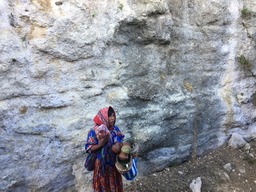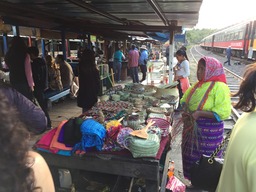
El Chepe
 El Chepe |
Taking the train would bring me far off-course from the direction I was heading. On top of that the rail fare would cost well more than what a bus ticket would. But, I was certainly not going to miss a trip riding the last passenger train running in Mexico. The terrain it crosses and the people who live in the area it runs through--everything about the journey sounded so compelling.
Half of the appeal was in the setting. Even loose physical descriptions of the Copper Canyon, the area that the train runs across, sounded amazing: "stunning... high, forested mountains... much deeper and larger than the Grand Canyon". In addition to the natural beauty, everything else I'd read about the area emphasized the indigenous culture of Tarahumara Indians living there--a people who had retained a distinct culture of traditional language, dress, and handicrafts that has endured colonial Spanish settlement and norms of modern Mexico to this day.
 View from El Chepe |
The formal name of the line is "Chihuahua Pacifico". But what everybody actually calls the train is "El Chepe". That's an abbreviation using the initial letters ch and p--much as the names of railroads in the U.S. such as the "L & N" and the "B & O" also became more commonly known by their respective initials than by the full, proper names of the areas they ran between.
The day I rode there were plenty of other passengers aboard. Many were clearly riding to get from point to point: families transporting big bags of personal goods, passengers boarding and disembarking at small stations and even getting off at odd stopping points in-between stations. Others were, like me, making the journey to experience the scenery and the setting. My fellow travelers in the second-class carriage were almost exclusively Mexican. The first-class carriage was dominated by a U.S. tour group of several dozen people who were led by a guide.
 Passenger Disembarks at Stop Between Stations |
Representing the latter category were the passengers who would immediately brag about other places they'd visited. Among the first things one woman said to me after we began speaking was how she had "heard the train would be making switchbacks along its route and that reminded her of when she went to Machu Picchu." I was happy to keep that conversation short. I assumed that anybody who wanted to drop such quick mention of another impressive trip she'd previously taken would be similarly one-sided in the remainder of any conversation.
 Tarahumara Basket Vendor Alongside Railway Track |
"Yes, that's exactly where I lived," I said. "How do you know about the Uyghurs? I usually have to explain to most people just who they are and how they're distinct from the rest of China,"
Her reply came in a Spanish idiom I couldn't fully understand:
"Más sabe el diablo por viejo que por diablo."
I admitted my lack of comprehension.
"Huh? You said, 'The devil knows... he knows... something... ', sorry, my Spanish isn't good enough to understand that expression."
She clarified:
"The really loose, non-literal translation would be something like, 'The Devil isn't wise because he's so clever. It's just on account of his being so old.' So, no, it's not that I know anything much about that area where the Uyghurs are. It's just that I've been around long enough to have heard of them at some point."
I thought that was a cool expression and the perfect way to explain having a little superficial knowlege about a subject.
In the morning when the conductor came around I had impulsively decided to buy a ticket not all the way to Chihuahua at the end of the line but to a closer station along the rim of the Copper Canyon: Creel. Getting off here turned out to be a much better choice. As the train pulled into Creel the last light after sunset was quickly fading. Continuing all the way to Chihuahua would have meant several more hours spent on the train rolling through darkness with nothing to see out the window. The Tarahumara Indian population around this town is far higher than I expect it to be in the big city at the end of the line.
 David with Rental Bike |
"Oh, yeah! It's the final game of the World Series tonight, isn't it? Are you going somewhere to watch the Cubs play?", I asked him.
Something in the way he paused in replying was enough of a clue for me to realize that I'd said something wrong.
"Or... ," I continued, "maybe you're backing the Indians?"
 David at Lake Arareko |
"Cleveland! I'm going to my friend's house who has a TV to watch the game with him. I'm going to wear my big shirt in support."
I paid him for a day's bike rental and started walking down the block with the bike I'd just rented. As I strolled away the owner dashed across the street then called out to me holding something up in his hands:
"See! Indians!"
He was waving about an extra-large navy-colored sweatshirt bearing a massive image of Chief Wahoo, the caricatured team mascot of big, toothy grin and feather sticking out from a headband. The huge logo covered the entire shirt from collar to lower hem. I tipped my Cubs cap--a red "C" against a blue field--back toward him in response.
 Basket Weaver - Divisadero, Mexico |
I found it interesting that somebody living here in a richly Indian town apparently didn't share the same concerns about the team name, mascot, or logo that people express north of the border.
Next stop: Tucson